

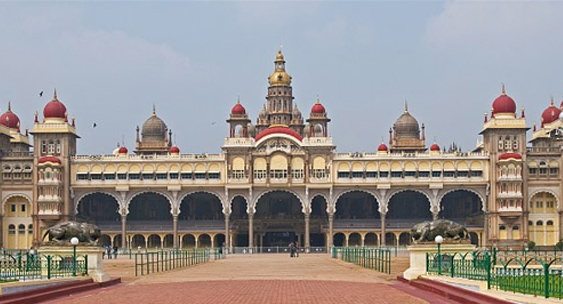 The Palace of Mysore is a historical palace in the city of Mysore in Karnataka, southern India. It is the official residence and seat of the Wodeyars - the Maharajas of Mysore, the royal family of Mysore, who ruled the princely state from 1399 to 1950. The palace houses two durbar halls (ceremonial meeting halls of the royal court) and incorporates a mesmerizing and gigantic array of courtyards, gardens, and buildings. The palace is in the central region of inner Mysore, facing the Chamundi Hills eastward.
The Palace of Mysore is a historical palace in the city of Mysore in Karnataka, southern India. It is the official residence and seat of the Wodeyars - the Maharajas of Mysore, the royal family of Mysore, who ruled the princely state from 1399 to 1950. The palace houses two durbar halls (ceremonial meeting halls of the royal court) and incorporates a mesmerizing and gigantic array of courtyards, gardens, and buildings. The palace is in the central region of inner Mysore, facing the Chamundi Hills eastward.
The palace is ten minutes from the city central railway station and from the suburb bus-stand; right behind city bus-stand, and twenty minutes (less four miles) from Mysore Airport. The domestic airport is directly connected to the international airports of Bangalore (Kempegowda International Airport), Chennai (Chennai International Airport), Thiruvananthapuram (Trivandrum International Airport), Hyderabad (Rajiv Gandhi International Airport), Mangalore (Mangalore international airport) and Bombay (Chhatrapati Shivaji International Airport). The city is connected through the state highway SH-17.
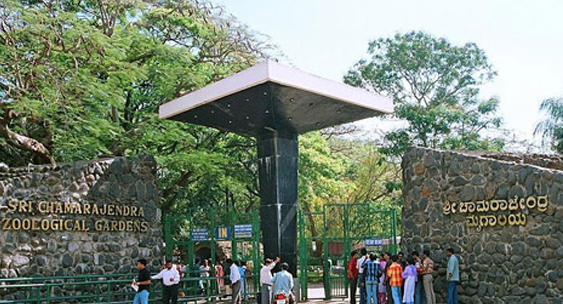 Mysore Zoo (officially the Sri Chamarajendra Zoological Gardens) is a 157-acre (64 ha) zoo located near the palace in Mysore, India. It is one of the oldest and most popular zoos in India, and is home to a wide range of species (168). Mysore Zoo is one of the city's most popular attractions. While mainly depending on entry fees for its financing, an adoption scheme introduced in the early 2000s has been a success. Celebrities, institutions, and animal lovers have contributed directly to the welfare of the zoo inmates
Mysore Zoo (officially the Sri Chamarajendra Zoological Gardens) is a 157-acre (64 ha) zoo located near the palace in Mysore, India. It is one of the oldest and most popular zoos in India, and is home to a wide range of species (168). Mysore Zoo is one of the city's most popular attractions. While mainly depending on entry fees for its financing, an adoption scheme introduced in the early 2000s has been a success. Celebrities, institutions, and animal lovers have contributed directly to the welfare of the zoo inmates
Distance between Mysore Railway Station to Mysore Zoo - 7 Mins (3 Km 457 Mtrs)
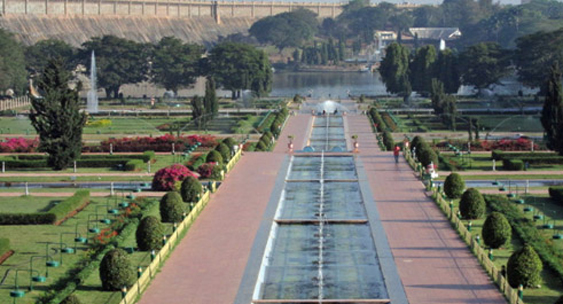 The Brindavan Gardens, a celebrated beauty spot in this part of India is world famous for its symmetric design. It is one of the most beautifully laid out terrace gardens in the world. The creation of this garden in the Krishnaraja Sagar Dam site has been the achievement of Sir Mirza Ismail, the then Dewan of the princely State of Mysore. The beautification of the whole dam complex was conceived by Sir Mirza Ismail. Modeled on the design of the Shalimar Gardens of Kashmir in the Mughal style, the garden is enriched with a number of terraces, parterres, fountains, running and cascading water channels, water chutes, lush green lawns, flower beds, shrubs and trees. Today, the Brindavan Gardens is world famous for its ethereal beauty, grandeur and illumination/ musical fountain.
The Brindavan Gardens, a celebrated beauty spot in this part of India is world famous for its symmetric design. It is one of the most beautifully laid out terrace gardens in the world. The creation of this garden in the Krishnaraja Sagar Dam site has been the achievement of Sir Mirza Ismail, the then Dewan of the princely State of Mysore. The beautification of the whole dam complex was conceived by Sir Mirza Ismail. Modeled on the design of the Shalimar Gardens of Kashmir in the Mughal style, the garden is enriched with a number of terraces, parterres, fountains, running and cascading water channels, water chutes, lush green lawns, flower beds, shrubs and trees. Today, the Brindavan Gardens is world famous for its ethereal beauty, grandeur and illumination/ musical fountain.
The Krishnaraja Sagar dam is built across the river Cauvery, one of the principal rivers in South India. The Cauvery rises in the hills of Brahmagiri - in Talacauvery, Kodagu District in the Western Ghats and traverses Eastwards in Karnataka for about 320 Km. before entering Tamil Nadu and finally joining the Bay of Bengal. The dam is named after Krishnaraja Wodeyar IV during whose rule the Chief Engineer, Sir M. Vishveswaraya engineered the construction of the dam. The River Cauvery below the giant dam divides the garden into two parts.
Located in the Krishnaraja Sagar dam site in Srirangapatna taluk of Mandya district, the Brindavan Gardens is at a distance of 24 Km. from the famous cultural heritage center of Karnataka - the city of Mysore, and 143 Km. from Bangalore, the capital city of Karnataka.
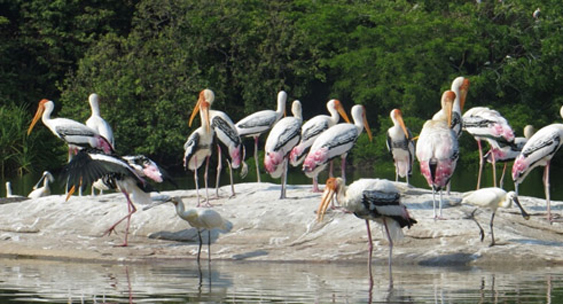 Another place that one should visit while on a trip to Mysore is the Ranganathittu Bird Sanctuary. It is a group of small islands in the Cauvery River.
Another place that one should visit while on a trip to Mysore is the Ranganathittu Bird Sanctuary. It is a group of small islands in the Cauvery River.
Ranganthittu was formed as a result of a small dam across the river Cauvery in the 1600s. The Bird Sanctuary at Ranganathittu owes its existence to the world famous ornithologist Dr. Salim Ali who convinced the Maharaja of Mysore in 1940 to declare Ranganthittu as a protected area. The sanctuary is not very large it covers an area of 0.67sq.km.But is home to a great variety of birds and a few reptiles. It is said that the sanctuary is a sight to behold during the nesting season of the birds from June to November. The sanctuary is home to a wide species of birds including cormorants, darters, white ibis, spoon billed storks, open billed storks, painted storks, white necked storks, egrets, herons, terns, swallows, kingfishers, sandpiper etc. There are a few mammals in the sanctuary like fruit bats, bonnet macaques, palm civets, common mongoose and common otters. Marsh crocodiles make up the reptile population of the sanctuary.
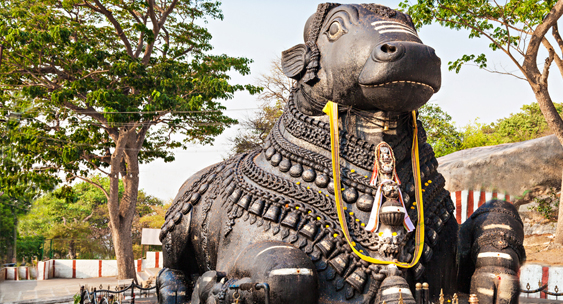 Chamundi Hills is famous not only in India but also abroad. At top of the hill the famous Sri Chamundeswari Temple. 'Chamundi' or 'Durga' is the fierce form of 'Shakti'. She is the slayer of demons, 'Chanda' and 'Munda' and also 'Mahishasura', the buffalo-headed monster.
Chamundi Hills is famous not only in India but also abroad. At top of the hill the famous Sri Chamundeswari Temple. 'Chamundi' or 'Durga' is the fierce form of 'Shakti'. She is the slayer of demons, 'Chanda' and 'Munda' and also 'Mahishasura', the buffalo-headed monster.
She is the tutelary deity of the Mysore Maharajas and the presiding deity of Mysore. For several centuries they have held the Goddess, Chamundeswari, in great reverence.
'Skanda Purana' and other ancient texts mention a sacred place called 'Trimuta Kshetra' surrounded by eight hills. Lying on the western side is the Chamundi Hills, one among the eight hills. In the earlier days, the Hill was identified as 'Mahabaladri' in honor of God Shiva who resides in the 'Mahabaleswara Temple'. This is the oldest temple on the hills.
Chamundi Hill is about 13 kms from Mysore, which is a prominent city in Karnataka State,India.
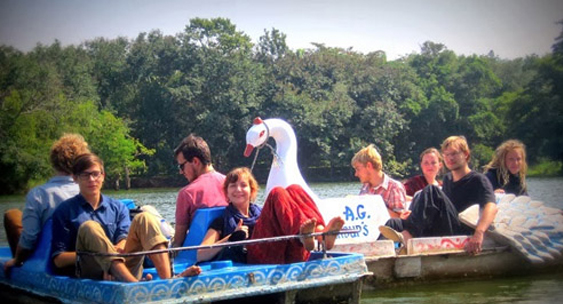 Built by the Mysore maharaja more than a century back, the Karanji Lake served as a percolation tank which was used by the locals for washing, bathing and drinking. Today, the lake is regarded as one of the biggest lakes in Karnataka, spread over an area of 90 acres. It harbors more than 90 species of resident and migratory birds, several species of butterflies and small mammals, thus providing an excellent example of a wetland ecosystem. The lake is the site for the largest walk through aviary in India, which is quite popular among visitors, especially avid birdwatchers. The birds are almost at touching distance as one takes a stroll on the walkway. Other attractions of the lake include a butterfly park (housing a large variety of plant species to attract butterflies), children's corner and boating facilities. There is a high view tower from where panoramic views of the entire landscape can be seen.
Built by the Mysore maharaja more than a century back, the Karanji Lake served as a percolation tank which was used by the locals for washing, bathing and drinking. Today, the lake is regarded as one of the biggest lakes in Karnataka, spread over an area of 90 acres. It harbors more than 90 species of resident and migratory birds, several species of butterflies and small mammals, thus providing an excellent example of a wetland ecosystem. The lake is the site for the largest walk through aviary in India, which is quite popular among visitors, especially avid birdwatchers. The birds are almost at touching distance as one takes a stroll on the walkway. Other attractions of the lake include a butterfly park (housing a large variety of plant species to attract butterflies), children's corner and boating facilities. There is a high view tower from where panoramic views of the entire landscape can be seen.
Located right behind the Mysore zoo, and close to the Regional Museum of Natural History, you can reach here via any available means of transport.
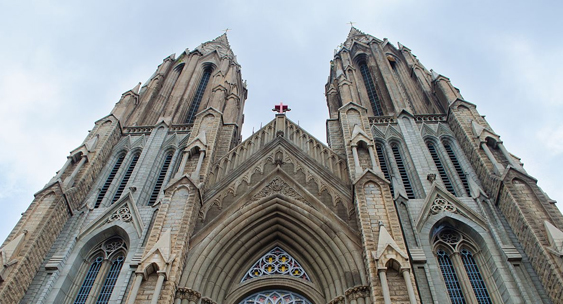 This Roman Catholic Church was built in AD 1840. It was initially known as St. Joseph Chaver which later assumed the present name. The twin towers of the church stand majestically at 175 feet, the design is gothic and it is said to resemble the St. Patrick's cathedral at New York and a church at Cologne. The then king of Mysuru Krishnaraja Wodeyar IV laid the foundation for construction of the church in 1933. It has been designed a French Architect.
This Roman Catholic Church was built in AD 1840. It was initially known as St. Joseph Chaver which later assumed the present name. The twin towers of the church stand majestically at 175 feet, the design is gothic and it is said to resemble the St. Patrick's cathedral at New York and a church at Cologne. The then king of Mysuru Krishnaraja Wodeyar IV laid the foundation for construction of the church in 1933. It has been designed a French Architect.
The church is located about 1 km from Mysuru Palace on the Bangalore highway.
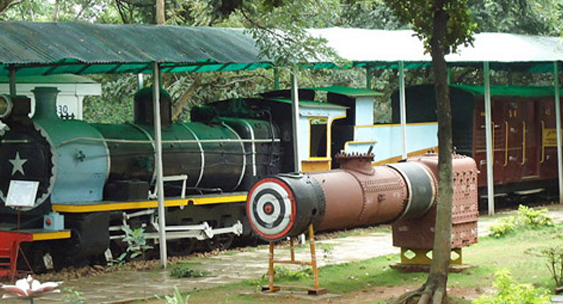 Located on Krishnaraja Sagar Road, the Railway Museum of Mysore is second only after the National Railway Museum, New Delhi. The museum is situated in front of the Central Food and Technology Institute and was set up in the year 1979.
Located on Krishnaraja Sagar Road, the Railway Museum of Mysore is second only after the National Railway Museum, New Delhi. The museum is situated in front of the Central Food and Technology Institute and was set up in the year 1979.
The Railway Museum has a number of galleries which depict the development and growth of railway systems in India. These can be noticed from the locomotives, photographs and painting depicted in these galleries. One can view the lights and signals which were initially used and even the mini railway which operated on battery.
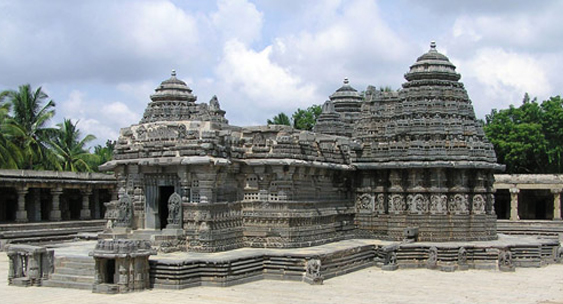 Somanathapuram Temple can be spotted near the Shivanasamudra Waterfalls. The temple is exquisitely carved in star shape and consists of triple towers. Intricate designs of Hoysala Architecture can be observed here. Images of caparisoned elephants, charging horsemen along with mythological birds and beast are arranged in rows on the outer walls of the temple. Sculpted images of gods and goddesses along with scenes from epics can be noticed here.
Somanathapuram Temple can be spotted near the Shivanasamudra Waterfalls. The temple is exquisitely carved in star shape and consists of triple towers. Intricate designs of Hoysala Architecture can be observed here. Images of caparisoned elephants, charging horsemen along with mythological birds and beast are arranged in rows on the outer walls of the temple. Sculpted images of gods and goddesses along with scenes from epics can be noticed here.
Located at a distance of 25 kms from Mysore.
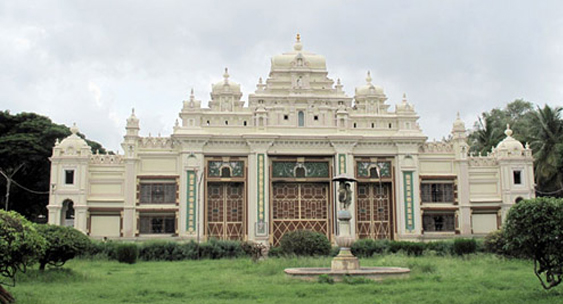 This Art Gallery located to the west with a walking distance to that of main palace, which is famous Art Gallery. It was built during rule of Krishnaraja Wodeyar III in 1861 to celebrate the marriage of his daughter, the princess of Mysuru, because the main palace was destroyed in a fire in 1897. The main door of this Museum is itself a master piece of Art with intricate carvings which is said to have been made in just 70 days. The museum was officially started in 1915, and has since been expended adding many artifacts. This Art Gallery was linden to the famous Mysuru style of painting of rare original paintings and artifacts and entrusted the Administration of this Museum to a committee. The museum was named after Sri Jayachamrajendra Wodeyar in 1955 as Jaganmohan Palace Art Gallery.
This Art Gallery located to the west with a walking distance to that of main palace, which is famous Art Gallery. It was built during rule of Krishnaraja Wodeyar III in 1861 to celebrate the marriage of his daughter, the princess of Mysuru, because the main palace was destroyed in a fire in 1897. The main door of this Museum is itself a master piece of Art with intricate carvings which is said to have been made in just 70 days. The museum was officially started in 1915, and has since been expended adding many artifacts. This Art Gallery was linden to the famous Mysuru style of painting of rare original paintings and artifacts and entrusted the Administration of this Museum to a committee. The museum was named after Sri Jayachamrajendra Wodeyar in 1955 as Jaganmohan Palace Art Gallery.
This is located in the main city near city bus stop
Dont hide your SMILE on the biggest day of your life. It's the most important thing for you and we can make you smile better.